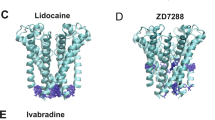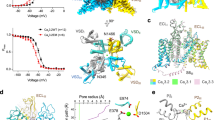Summary
Benzothiazinones represent a novel class of drugs which block voltage-dependent L-type calcium channels in different tissues. [3H]HOE166 (R-(±)-3,4-dihydro-2-isopro-opyl-4-methyl-2-[2-[4-[4-[2-(3, 4, 5-trimethoxyphenyl)ethyl]piperazinyl]butoxy]phenyl]-2H -1, 4-benzothiazin-3-on-dihydrochloride; ≈ 57 Ci/mmol) a potent optically pure benzothiazinone was employed to characterize receptors associated with skeletal muscle transverse tubule calcium channels. [3H]HOE166 reversibly labels the membrane-bound calcium channels with high affinity (Kd = 0.36 ± 0.05 nM; Bmax = 18.2 ± 3.3 pmol/mg of membrane protein; means ± SD, n = 13), HOE166 (Ki = 0.76 nM) is 29-fold more potent than the respective (S)-enantiomer (Ki = 22.1 nM). Binding is inhibited by divalent and trivalent cations (Cd2+ and La3+ being most potent) and other calcium channel drugs (1,4 dihydropyridines, phenylalkylamines, benzothiazepines). High affinity [3H]HOE166 binding activity is maintained (Kd = 4.5–9.0 nM) after solubilization and purification (554–1350 pmoles/mg of protein) of the calcium channel complex from transverse-tubule membranes. The following data support our recent claim (Striessnig et al. 1985, 1988) that HOE166 labels a domain on L-type calcium channels which is distinct from that defined by 1,4 dihydropyridines, phenylalkylamines or benzothiazepines: (1) All 1,4 dihydropyridine-, phenylalkylamine-and benzothiazepine-receptor-selective drugs tested are only very weak inhibitors of [3H]HOE166 binding. (2) (+)-PN200-110 only partially inhibits [3H]HOE166 binding to the purified calcium. channel complex. (3) The decay of the [3H]HOE166-receptor complex is monoexponential but the dissociation rate constants depend on the ligand concentration; (+)-PN200-100 accelerates the dissociation in the presence of unlabelled HOE166. (4) Nanomolar concentrations of HOE166 and HOE167 completely inhibit (−)-[3H]desmethoxyverapamil binding to a Drosophila phenylalkylamine receptor (which lacks a 1,4 dihydropyridine binding domain). Taken together, these results are incompatible with the view that [3H]HOE166 binds competitively to the calcium channel linked 1,4 dihydropyridine drug receptors.
Similar content being viewed by others
Abbreviations
- kd:
-
dissociation constant
- Ki :
-
inhibition constant
- k−1,k+1 :
-
dissociation, association rate constant
- SDS:
-
sodium dodecyl sulfate
- T-tubule:
-
transverse tubule
- s20,w :
-
sedimentation coefficient
References
Boer R, Grassegger A, Schudt C, Glossmann H (1989) (+)-Niguldipine binds with very high affinity to calcium channels and to a subtype of alphal-adrenoceptors. Eur J Pharmacol 172:131–146
Bradford MM (1976) A rapid and sensitive method for the quantitation of microgram quantities of protein utilizing the principle of protein-dye binding. Anal Biochem 72:248–254
Cheng Y-C, Prusoff WH (1973) Relationship between the inhibition constant (Ki) and the concentration of inhibitor which causes 50% inhibition (IC50) of an enzymatic reaction. Biochem Pharmacol 22:3099–3108
De Lean A, Munson PJ, Rodbard D (1978) Simultaneous analysis of families of sigmoid curves: Application for bioassays, radioligand assays and physiological dose-response curves. Am J Physiol 4:E97-E102
De Lean A, Rodbard D (1979) Kinetics of cooperative binding. In: O'Brien RD (ed) The receptors. A comprehensive treatise. Plenum Press, New York and London, pp 143–192
De Meyts P, Bianco AR, Roth J (1976) Site-site interactions among insulin receptors: Characterization of the negative cooperactivity. J Biol Chem 251:1877–1881
De Meyts P, Roth J (1975) Cooperativity in ligand binding: A new graphic analysis. Biochem Biophys Res Commun 66:1118
Dohlman HG, Bouvier M, Benovic JL, Caron MG, Lefkowitz RJ (1987) The multiple membrane spanning topography of the beta2-adrenergic receptor. J Biol Chem 262:14282–14288
Ehlert FJ (1988) Estimation of the affinities of allosteric ligands using radioligand binding and pharmacological null methods. Mol Pharmacol 33:187–194
Glossmann H, Ferry DR (1985) Assay for calcium channels. Meth Enzymol 109:513–550
Glossmann H, Ferry DH, Goll A, Striessnig J, Schober M (1985) Calcium channels: basic properties as revealed by radioligand binding studies. J Cardiovasc Pharmacol 7:20–30
Glossmann H, Linn T, Rombusch M, Ferry DR (1983) Temperature-dependent regulation of d-cis-[3H]diltiazem binding to Ca2+ channels by 1,4-dihydropyridine channel agonists and antagonists. FEBS Lett 160:226–232
Glossmann H, Striessnig J (1988) Calcium channels. Vitam Horm 44:155–328
Glossmann H, Striessnig J, Hymel L, Schindler H (1988) Purification and reconstitution of calcium channel drug-receptor sites. Ann NY Acad Sci 522:150–161
Glossmann H, Striessnig J, Knaus HG, Müller J, Grassegger F, Höltje H-D, Marrer S, Hymel L, Schindler H (1989) Structure of calcium channels. Ann NY Acad Sci 560:198–214
Goll A, Ferry DR, Glossmann H (1984a) Target size analysis and molecular properties of Ca2+ channels labelled with [3H]verapamil. Eur J Biochem 141:177–186
Goll A, Ferry DR, Striessnig J, Schober M, Glossmann H (1984b) (−)-[3H]Desmethoxyverapamil, a novel Ca2+ channel probe. Binding characteristics and target size analysis of its receptor in skeletal muscle. FEBS Lett 176:371–377
Greenberg RM, Striessnig J, Koza A, Devay P, Glossmann H, Hall LM (1989) Native and detergent-solubilized membrane extracts from Drosophila heads contain binding sites for phenylalkylamine calcium channel blockers. Insect Biochem 19:309–322
Janis RA, Silver PJ, Triggle DJ (1987) Drug action and cellular calcium regulation. Adv Drug Res 16:309–591
Leung AT, Imagawa T, Campbell KP (1987) Structural characterization of the 1,4-dihydropyridine receptor of the voltage-dependent Ca2+ channel from rabbit skeletal muscle. Evidence for two distinct high molecular weight subunits. J Biol Chem 262:7943–7946
Linden J (1982) Calculating the dissociation constant of an unlabeled compound from the concentration required to displace radiolabel binding by 50%. J Cyclic Nucleotide Res 8:163–172
Lowry OH, Rosebrough NJ, Farr AL, Randall RJ (1951) Protein measurement with the Folin Phenol Reagent. J Biol Chem 193:265–275
Mir AK, Spedding M (1987) Calcium antagonist properties of diclofurime isomers. II. Molecular aspects: allosteric interactions with dihydropyridine recognition sites. J Cardiovasc Pharmacol 9:469–477
Pauron D, Qar J, Barhanin J, Fournier D, Cuany A, Pralavorio M, Berge JB, Lazdunski M (1987) Identification and affinity labeling of very high affinity binding sites for the phenylalkylamine series of Ca2+ channel blockers in the Drosophila nervous system. Biochemistry 26:6311–6315
Pelzer S, Barhanin J, Pauron D, Trautwein W, Lazdunski M, Pelzer D (1989) Diversity and novel pharmacological properties of Ca2+ channels in Drosophila brain membranes. EMBO J 8:2365–2371
Qar J, Barhanin J, Romey G, Henning R, Lerch U, Oekonomopulos R, Urbach H, Lazdunski M (1988) A novel high affinity class of Ca2+ channel blockers. Mol Pharmacol 33:363–369
Reynolds IA, Snowman AM, Snyder SH (1986) (−)-[3H]Desmethoxyverapamil labels multiple calcium channel modulator receptors in brain and skeletal muscle membranes: differentiation by temperatures and dihydropyridines. J Pharmacol Exp Ther 237:731–738
Romey G, Garcia L, Rieger F, Lazdunski M (1988) Targets for calcium channel blockers in mammalian skeletal muscle and their respective functions in excitation-contraction coupling. Biochem Biophys Res Commun 156:1324–1332
Striessnig J (1989) Identification of the purified calcium channel benzothiazepine receptor by photoaffinity labelling and anti-benzothiazepine antibodies. Naunyn-Schmiedeberg's Arch Pharmacol 339:R44
Striessnig J, Goll A, Moosburger K, Glossmann H (1986a) Purified calcium channels have three allosterically coupled drug receptors. FEBS Lett 197:204–210
Striessnig J, Moosburger K, Goll A, Ferry DR, Glossmann H (1986b) Stereoselective photoaffinity labelling of the purified 1,4-dihydropyridine receptor of the voltage-dependent calcium channel. Eur J Biochem 161:603–609
Striessnig J, Knaus HG, Grabner M, Moosburger K, Seitz W, Lietz H, Glossmann H (1987) Photoaffinity labelling of the phenylalkylamine receptor of the skeletal muscle transverse-tubule calcium channel. FEBS Lett 212:247–253
Striessnig J, Meusburger E, Grabner M, Knaus H-G, Glossmann H, Kaiser J, Schölkens B, Becker R, Linz W, Henning R (1988) Evidence for a distinct calcium antagonist receptor for the benzothiazinone compound HOE166. Naunyn-Schmiedeberg's Arch Pharmacol 337:331–340
Takahashi M, Seagar MJ, Jones JF, Reber BF, Catterall WA (1987) Subunit structure of dihydropyridine-sensitive calcium channels from skeletal muscle. Proc Natl Acad Sci [USA] 84:5478–5482
Tejdor FJ, Catteral WA (1988) Site of covalent attachment of alpha-scorpion toxin derivatives in domain I of the sodium channel alpha subunit. Proc Natl Acad Sci [USA] 85:8742–8746
Triggle DJ, Janis RA (1987) Calcium channel ligands. Annu Rev Pharmacol Toxicol 27:347–369
Vaghy PL, Striessnig J, Miwa K, Knaus HG, Itagaki K, McKenna E, Glossmann H, Schwartz A (1987) Identification of a novel 1,4-dihydropyridine- and phenylalkylamine-binding polypeptide in calcium channel preparations. J Biol Chem 262:14337–14342
Zech C, Greenberg RM, Hall L (1989) Very high affinity interaction of sodium channel ligans with drosophila head membranes. Naunyn-Schmiedeberg's Arch Pharmacol 339:R45
Author information
Authors and Affiliations
Additional information
Send offprint requests to H. Glossmann at the above address
Rights and permissions
About this article
Cite this article
Grassegger, A., Striessnig, J., Weiler, M. et al. [3H]HOE166 defines a novel calcium antagonist drug receptor — distinct from the 1,4 dihydropyridine binding domain. Naunyn-Schmiedeberg's Arch Pharmacol 340, 752–759 (1989). https://doi.org/10.1007/BF00169685
Received:
Accepted:
Issue Date:
DOI: https://doi.org/10.1007/BF00169685




